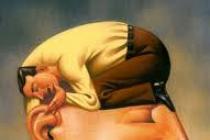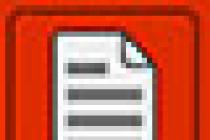Symbol @ mainly used in Internet e when writing an email address. It serves as a kind of separator between the domain name on which the email is registered and the username.
Now many Internet personalities call this symbol "one of the main pop symbols of our time." Evidence of universal recognition for this symbol is that in February 2004, the symbol was introduced into Morse code, in which it combines the codes for the Latin letters A and C. Now this symbol can be proudly called the "international telecommunication union."
But this symbol, which has only recently received recognition, is not as young as one might think. Italian researcher Giorgio Stabile in the city of Prato, in the archives of the Institute economic history found a document on which this sign is first found in writing. The document, dated 1536, turned out to be a letter from a merchant, and a symbol @ it denoted containers with wine delivered on merchant ships to Spain. After analyzing the data, scientists came to the conclusion that most likely the symbol @ a measured unit was designated, equal to the ancient universal measure of volume - amphora.
The American scientist Berthold Ullman suggested that the symbol @ invented by medieval monks. And the symbol was used to reduce the word of the Latin language - " ad”, which is one of the universal words, and meaning “in”, “on”, “in relation to” and the like.
In French, Portuguese and Spanish, the name of the character @ comes from the ancient word "arroba" - a Strao-Spanish measure of weight, equal to about fifteen kilograms, which in writing is abbreviated by the symbol @ .
Symbol @ now has an official name - " commercial at". This name originates from the accounts. Since the symbol was often used in business, it was decided to place it on typewriter keyboards. Symbol @ was already present on the keyboard of the first Underwood typewriter, which was released in 1885. Later, this symbol was inherited by computer keyboards.
According to the official history of the Internet, it is generally accepted that the symbol @ appeared in the email address thanks to Ray Tomlinson, an American computer scientist and engineer. It was he who sent the first electronic message back in 1971. He chose the symbol @ as a separator between two names, since this character did not occur in the names themselves.
In Russia, it is customary to call the symbol @ "dog". This funny name can be explained in several ways. For starters, the symbol itself is visually similar to a dog curled up. And the sound of the English word "at", which is part of the official name, is slightly reminiscent of a dog barking. Also, if you turn on the imagination, then in the symbol @ you can see all the letters from the word "dog", only with the exception of the letter "k".
There is also a more interesting version of the origin of this name. Long ago, when computer displays were exclusively text, there was a popular electronic game called " Adventure or "Adventure". The game was a journey through labyrinths, in which treasures were hidden, but also through which underground monsters roamed. The labyrinth consisted of the symbols "+", "-" and "!", and the player, treasures, and monsters were indicated by various letters and signs. According to the plot, in the game the player had a faithful companion and friend - a dog who went on reconnaissance. And this dog was designated by the symbol @ . But it is not known whether the symbol was already called a dog at that time, or, on the contrary, this was the root cause of this name.
It is also worth noting that in Russia the symbol @ in addition to "dog", they call "ram", "ear", "bun", "frog" and even "kryakozyabra".
As already mentioned, in France, Spain and Portugal, the symbol is called "arroba". America and Finland @ called "cat", "mouse" in China and Taiwan, "monkey" in Poland, Croatia, Holland, Romania, Serbia, Germany and Slovenia, "snail" in Italy, "worm" or "tick" in Hungary, "rosette" in Turkey, whirlpool in Israel, rollmops in the Czech Republic and Slovakia, little pasta in Greece, crooked A in Vietnam, monkey A in Bulgaria, monkey tail in the Netherlands, cat tail in Finland, "elephant trunk" in Denmark, Norway and Sweden, and in Latvia and Lithuania - "et" and "this".
It is unlikely that among the Internet audience there will be a person who is unfamiliar with this @ symbol. On the web, it is used as a separator between username and hostname in email address syntax.
Some figures in the Internet space call this symbol "one of the main pop symbols of our time, a sign of our common communication space." Somewhat grandiloquently, in my opinion, but the following fact testifies to the worldwide recognition of this symbol, and as it is even sometimes noted, “canonization”.
In February 2004, the International Telecommunication Union introduced a code for the @ symbol ( - - - ) in Morse code, to facilitate the transmission of email addresses. The code combines the Latin letters A and C and reflects their joint graphic writing.
The search for the origins of the @ symbol takes us back at least to the 15th century, and perhaps even further, although linguists and paleographers still disagree on this issue.
Professor Giorgio Stabile put forward such a hypothesis. A 16th-century document written by a Florentine merchant mentioned "the price of one A of wine" (possibly an amphorae). At the same time, the letter A, according to the then tradition, was decorated with a curl and looked like @.
The American scholar Berthold Ullman suggested that the @ sign was invented by medieval monks to shorten the Latin word "ad", which was often used as a universal word meaning "on", "in", "in relation", etc. In the script used by the monks, the letter "d" was written with a small tail, and this made it look a bit like the number "6" in a mirror image. So the preposition "ad" became the symbol @.
Be that as it may, this innovation was soon adopted by merchants: one of the first to use the symbol outside the walls of the monastery was the Florentine merchant Francesco Lapi, who in one of his letters designated an amphora as a “dog”, a standard measure of volume in those days, approximately equal to 26 -ty l.
In Spanish, Portuguese, French, the name of the symbol comes from the word "arroba" - an old Spanish measure of weight, approx. 15 kg. (according to other sources, 11.502 kg), which was abbreviated on the letter with the @ sign.
During the Renaissance, the @ sign began to be used to indicate the price, but in the era of the industrial revolution, the @ sign began to appear in the reports of accountants. The modern official name for the symbol "commercial at" comes from bills, for example, 7 widgets @ $2 each = $14, which translates to 7 widgets. 2$ = 14$. Since this symbol was used in business, it was placed on the keyboards of typewriters and from there migrated to the computer.
We owe the distribution of this symbol on the network to the forefather of e-mail, Tomlinson. He was the one who chose the @ symbol.
Here we need to digress a little and enlighten you about what Tomlinson did and why it is he who is considered to be the inventor of the email, and at the same time the @ sign, when in fact he did neither. The company where Tomltson worked became a member of the ARPANet project, a computer network for the US Department of Defense, around the late 60s. This network was the forerunner of the Internet. In those years, there were already several programs that were able to transfer a file or message from one person to another. But the sender and recipient needed to use the same computer. As for the modem, even the fastest at that time worked about 200 times slower than a modern ordinary one, which allows you to download information at a speed of 56.6 Kbps.
Tomlinson was just at that time developing a mail program and creating a virtual mailbox. In fact, the email box of that time was a file that differed from the usual one in only one feature - users did not have the opportunity to correct the sent text, but only add something of their own. Only two programs were used in such an operation - SNDMSG in order to send the file and READMAIL in order to read it.
Tomlinson also wrote a new program, which consisted of 200 lines of code. Such a program was a cross between the above two programs and the CPYNET protocol, which was used on the ARPANet to send files to a remote computer. Tomlinson's first experimental message was sent from one computer in the lab to another.
In order to forward the file, Tomlinson spent about six months until he managed to send a message to a computer that could indeed be considered remote.
Of course, not very many people knew about Tomlinson's success, only a circle of colleagues, since the merit was not covered anywhere.
Well, now you can return to the "dog". Tomlinson used a 33 Teletype keyboard. And one day he needed a fairly unique symbol that had not been widely used before. Such a character was not supposed to appear in any name or name, and it also had to separate the username and computer name. An algorithm should have been obtained according to the type of name - symbol - place.
In addition to numbers and letters, there were punctuation marks on the keyboard, as well as @. But after 1971, the keyboard model has changed.
@ was the most simple solution such an algorithm. According to Tomlinson himself, this was the only option. When asked much later why he chose this particular icon, he replied simply: "I was looking on the keyboard for a character that could not appear in any name and cause confusion."
Clickable
In 1963, the ASCII standard encoding appeared, among the 95 printed characters of which there was also a “dog”, and in 1973, members of the Internet Engineering Taskforce secured the use of a character when separating a name and domain - this idea in 1971 th year put forward by the programmer Ray Tomlinson.
Such a symbol was needed by Tomlinson at the time when he was working on the creation of a messaging system in the Arpanet network (the progenitor of the Internet). In fact, he had to come up with a new addressing scheme that would identify not only the recipients, but also the computers on which their mailboxes were located. To do this, Tomlinson needed a separator, and his, in general, random choice fell on the @ sign.
The first network address was [email protected] The mass "dog" became in 1996, when the Hotmail service appeared.
About a year after the events described above, Vintan Cerf and Bob Kahn invented a protocol called TCP/IP. And this was also mentioned for a long time only in narrow circles.
In general, the history of the Internet is quite recent, all historical figures are still alive, so it would be fair to mention the people who had a hand in creating e-mail.
One of the creators is Douglas Engelbart (here is the story of this invention). He made a computer mouse and created the first text messaging system. After that, Tomlinson presented it in the form of an envelope with the field of the recipient, sender and address and the text of the letter. After that, the program was processed by Lawrence Roberts, who came up with a list of letters, reading the letter selectively and saving the information in a separate file and forwarding.
Tomlinson, it should be noted, was quite amused by the hype that unfolded on the 30th e-mail.
Despite the fame that has descended on him, he comes across as an ordinary person, although he scoffs at the fact that e-mail, according to everyone else, appeared in one day. And it wasn't 30 years ago either. The history of the @ sign is a rather funny epic that is connected with the first message. There are two legends about this.
The first version of what was contained in the historic first letter was that Tomlinson typed QWERTYUIOP - that is, the entire top row of letters from left to right. On this occasion, journalists raised a lot of noise. They were interested in what was written, and clearly expected something significant and symbolic. Since Tomlinson was by no means a public person, he did not realize that he could say anything.
He quite honestly answered about the body of the letter, since he did not suspect at all that it could turn out to be historical. But journalists need zest, not platitudes. Therefore, I did not really want to inform everyone that the letter turned out to be a random set of letters. Therefore, QWERTYUIOP appeared. And the engineer does not think to refute this version.
And the second version is that he wrote a quote from Lincoln's Gettysburg speech. One must think that the scientist is simply teasing journalists to the fullest and scoffing as best he can. It would be strange if he actually wrote something sublime in every experimental letter. But the journalists liked this version enough, and they began to repeat it.
In Russia, users most often refer to the “@” symbol as a “dog”, which is why e-mail addresses formed from personal names and surnames sometimes take on unexpected coloring. It is curious that this symbol is used in their work by both folk talents (for example, the joke: “The dog is gone, @ do not offer”), and official jokes - KVN players (for example, “ [email protected]»).
But still: why "dog"? There are several versions of the origin of this funny name.
First, the badge really looks like a curled up dog.
Secondly, the abrupt sound of the English “at” is a bit like a dog barking.
Thirdly, with a fair amount of imagination, you can consider almost all the letters included in the word “dog” in the outlines of the symbol, well, perhaps, with the exception of “k”.
But the most romantic is the following legend: “Once upon a time, when computers were large and displays were exclusively text, there was a popular game with the simple name “Adventure” (“Adventure”). Its meaning was to travel through a computer-generated labyrinth in search of treasures and battles with harmful underground creatures. At the same time, the labyrinth on the screen was drawn with the symbols "!", "+" and "-", and the player, treasures and hostile monsters were indicated by various letters and icons. Moreover, according to the plot, the player had a faithful assistant - a dog who could be sent to the catacombs for reconnaissance. And it was denoted, of course, by the @ sign.
Whether this was the root cause of the now generally accepted name, or, conversely, the icon was chosen because it was already called that, the legend is silent about this.
In fairness, it should be noted that in Russia a “dog” is also called a dog, a frog, a bun, an ear, a ram, and even a kryakozyabra.
In other countries, this symbol is associated with different objects. The following is a far from complete list of how the "@" symbol is called in other countries.
Italians say “chiocciola” (“snail”), in Greece it is known as “παπακι” - “duck”, in the Czech Republic and Slovakia - “zavináč” -rollmops - (“herring roll” or marinated herring), in Taiwan use the concept "小老鼠" (pronounced "xiao lao shu") - "mouse", in Israel the name "שטרודל" - "strudel" is common, and in Kazakhstan the sign is called "aiқұlaқ" - "ear of the moon".
Bulgaria - klomba or maimunsko a ("monkey A"),
Netherlands - apenstaartje ("monkey's tail"),
Spain - like the measure of weight "arroba",
France - the same measure of weight "arrobase",
Germany, Poland - monkey tail, monkey ear, paper clip, monkey,
Denmark, Norway, Sweden - "snabel-a" - "snout a" or elephant trunk,
America, Finland - cat,
China, Taiwan - mouse,
Turkey - rose,
in Serbia - "crazy A",
in Vietnam - "twisted A",
in Ukraine - “ravlik” (snail), “doggie” or, again, “dog”.
As you can see, for many nations, the @ sign evokes an association with a snuggly animal, for some with an appetizing strudel or herring roll, the poetic Turks compared it with a flower, but the disciplined Japanese use the English “attomark” without any poetic comparisons.
sources
http://www.factroom.ru/facts/40864#more-40864
http://shkolazhizni.ru/archive/0/n-7999/
http://viva-woman.ru/novosti-so-vsego-sveta/kak-pojavilsja-simvol-sobaka.html
I am glad to welcome dear users on the page of my blog. Many jargons from the global network have tightly entered our lives. These memes include cake, trouble, life hack, trolling, and so on. However, among all the widespread and gaining popularity of Internet jargon in Runet, the first place is occupied by “dog”.
This icon, familiar to the entire Internet audience, has an official name - "commercial at", and it looks like this: @. On the web, it is used to designate an address. It separates the username from the hostname. Therefore, everyone who has visited any site at least once has come across it. At the same time, it is called differently in different countries:
- Holland - monkey and tail, in the original apenstaartje;
- Ukraine - doggie;
- Spain - arroba, which means a measure of weight;
- Italy - snail, the original word is chiocciola;
- PRC - mouse;
- Denmark - elephant trunk and other names;
- Germany - the tail or ear of a monkey;
- Israel - strudel.
This is only a small part of the names of the @ symbol in different countries, and in Russia it is a "dog" for most users. Despite the fame, few people know why the "dog" is called that. The symbol is called so all the time, when, for example, they dictate their email address in a personal conversation or on the phone. All people have long been accustomed to this. Therefore, the other interlocutor understands everything and correctly writes down the voiced email address.
An exception may be a foreigner, who is more likely to go into a stupor, unless he lives in Russia or constantly communicates with Russian people. The thing is that the @ sign is called "dog" exclusively by Russian-speaking users. The history of the appearance of this symbol in the addresses of electronic mailboxes and on the “clave” of a computer is also interesting. This is what I will talk about next.
The correct pronunciation of the @ sign
Almost always, Russians pronounce the word "dog" when dictating their email address. It still represents the main official channel for contacts. The popularity of email is not affected even by a large number of instant messengers from different developers. Through e-mail, users often send official letters and exchange various media files, including photos and short videos.
When an e-mail address is transmitted verbally, it is at this point that the so-called "dog" problem appears. At the same time, it is absent when writing an email on paper or when it is transmitted using an SMS message. The problem is that the word "dog" is in certain situations like a curse. Therefore, many people have to think before pronouncing it. At the same time, some of them have a question: “why does the @ sign have such a name?”.
To fully answer this question, you need to understand everything in order. So, the @ symbol is really commonly called a "dog". Confirmation of this jargon is the use of this word both on television and in the press. However, the media is not always a role model for expressing one's thoughts and even behavior. Therefore, everyone needs to know how the @ symbol is officially called, so that if necessary, you can quickly convey to the interlocutor what you have in mind if, for example, he is a foreigner.
At the official level, the @ sign correctly sounds like "at". English-speaking users designate it with the word "at". This is where the pronunciation comes from. Moreover, in English this word is a preposition. In translation into Russian, it can have a different meaning. It directly depends on the constructed phrase. Therefore, in standard encodings, the symbol "dog" is specified as "commercial at".
English "at" translated into Russian means location. However, it can still be used as a preposition, for example, "in", "by", "on", and in some cases this English word can be used as "about". In connection with this translation, the @ symbol was chosen to denote electronic addresses. And then everything falls into place. So, having an email address, for example, [email protected], it can be sorted out: a user whose name is 12751013 on the mail.ru server.
However, we need to return to the question: “why is at commercial?”. Because some of the most meticulous accountants in the world, the British began to use the @ symbol as an abbreviation of the preposition "at" several centuries ago when compiling accounting documentation. For example, 11 rolls of fabric @ 2000 rubles = 22000 rubles. In other words, 11 rolls of 2000 rubles. will cost 22,000 rubles. This is why at is commonly considered a commercial pretext.
Its use has become so commonplace that with the invention of typewriters on such devices, the @ symbol has gained its own place in the row of numbers and punctuation marks. Subsequently, with the advent of personal computers, which inherited the layout from typewriters, the “dog” sign also began to be used on the keyboard. Now you know the path from the appearance of the @ symbol to the beginning of its use in designating electronic addresses that appeared in the 2nd half of the 20th century.
So anyway, why was "dog" chosen to split the email address? Here we need to clarify that this symbol is used not only in email, but also when writing a URL. In the latter case, @ is used to separate the username and password from the address of a particular page. However, this way of writing URLs is rarely used.
The @ sign has also found its place on Twitter. See him in this social network, which is a popular thumbnail blogging, is possible when a reply message is being typed. This symbol must be written before the name of the responding user. After that, he migrated to modern templates for forums and other social platforms.
It was already mentioned earlier that using @ when writing an email address is quite logical in connection with the meaning of the preposition at. In other words, a person can voice their email like this: ivanov on mail.ru. This pronunciation of the email address does not contradict any rules and is 100% correct!
It is worth noting that the programmer Tomlinson came up with the idea of recording email in the form it has now. This designation first appeared in 1971. The @ symbol separated the username from the server.
When the Russian layout is used on the computer, then in order to write “dogs”, it is first necessary to switch to English. This action is performed using special keys. For such purposes, the combination Shift + ALT is used. Shift + Control is also often used. In addition, switching can be done by clicking the language icon on the taskbar, selecting the desired layout.
Why is the name "dog" chosen?
There are various versions of why it is customary to call the @ sign in Runet a “dog”:
- The symbol is very much like a dog curled up.
- The abrupt pronunciation of "at" is a bit like a dog barking.
- If you strain your imagination and carefully look at the outline of the sign, then you can see almost all the letters that are necessary to write the word "dog". The exception is "k".
In addition to these options, there is one legend. It has romantic overtones. So, many decades ago, when the first computers were large devices with displays that were exclusively text, people played the game "Adventure" (English name "Adventure"). In it, users went through a maze created by the PC. They needed to find treasures, while killing various creatures living underground.
Symbols such as "-", "+" and "!" were used to draw the labyrinth on the monitor. At the same time, different signs and letters were used to designate the player, treasures and monsters. The game was also attended by a dog, which was a faithful assistant to the playing person. He usually performed reconnaissance in the maze at the player's command. But it was the @ symbol that was used to designate it.
This legend is silent about whether it is the reason for the appearance of the name "dog" for the @ sign. It is also worth mentioning that among Russian-speaking users this symbol is also called:
- frog;
- ram;
- dog;
- bun;
The familiar name of the @ sign in Russia appeared in the 80s of the XX century. At this time, the computerization of the population began in the country. During this period, people in Russia began to gradually get to know what e-mail is. And those were only selected users.
Instead of a conclusion
To understand exactly why the sign "dog" is so called, none of us today can be 100% able to recognize. Time is lost and tails will not be found. The name of the @ symbol has already become a tradition: I say it because everyone says it. Should we continue to use this name? Some may strongly disagree with this. Some, on the contrary, believe that the name "dog" makes us all mysterious personalities in the eyes of users from other countries, with the exception of the CIS countries (perhaps only for the time being).
However, foreigners are also not far behind us. Instead of "et", they use some of their own name, for example, snail. In many countries, users associate the @ symbol with an animal, in other states - with a herring roll or a delicious strudel.
But you, my readers, will now know exactly what is hidden behind the little squiggle in your e-mail address.
Today we have the "dog" icon, which, if we stick to a scientific approach, is officially called "commercial at", it looks something like this: @. Familiar? Well, a dog, an “incomprehensible icon”, “but with a tail” and even a “monkey”. But mostly it's the dog. Why and where did this name come from? Many are perplexed, but still continue to say something like “Petrovinvest dog mail.ru” when dictating (for example, their Email on the phone). It doesn't always sound good.
Moreover, on the other end of the wire, he will most likely be understood correctly if he is not a foreigner or a Russian-speaking comrade who has long been living in a foreign land. For the latter, “dog” (especially if this word is translated into the language of the opponent) causes a stupor. The fact is that this designation took root only in Runet, and in bourgeois the @ symbol as soon as they don’t call it, but not like us. Curious, by the way, is the history of the appearance of this icon both on the keyboard and in Email addresses. Actually, this is what this post is about.
How to pronounce the @ sign correctly - dog, doggy or ...
So, in 99.9 percent of cases, our compatriots are forced to "stand out" in the process of oral transmission to someone. Despite the dominance of instant messengers, the usual email. mail is still the de facto main contact channel (in any case, the official one). Most often, it is Emails that are exchanged if necessary to contact or receive some materials (pictures, documents, etc.).
Well, if it is possible to write to the opponent "your soap" on a piece of paper or send it in an SMS message. The problem with the “dog” comes out precisely when it is necessary to transmit Email by voice. It’s not a problem to convey Latin characters using names (by first letters), but the @ sign not only confuses many, but makes you wonder if it would be correct to call it a “dog” (like a dirty word). And why actually "sobakevich"?
So, first things first. Yes, calling the @ icon a dog is perfectly acceptable(in any case, this jargon is not shy on television and in the press, although they can hardly serve as examples of correct behavior and expression of one's thoughts). However, it would be better to understand what is at stake, and if yours does not understand you, then quickly correct yourself and issue another (officially correct, not jargon) sound designation of the @ symbol.
Actually, it's pronounced like "et"(from English at). This sign is written as "commercial at". Why commercial? Well, because the English word at itself is a preposition that has several translation variations in Russian (meanings - the Russian language is great and mighty). For example, it can be the preposition "on", "by" or "in" (sometimes "around"), but in general it is usually indicates the location.
By the way, that is why its symbolic designation (the @ sign) was chosen to display Email addresses. See how everything falls into place..ru”, i.e. But I ran ahead a bit. We had a question - why "@" is called the commercial at. Here again, everything is quite logical.
For abbreviations in English accounts (accounting documentation), several hundred years ago, it became customary to write a single @ sign instead of the word at. For example, like this: 7 articles @ 5 thousand rubles = 35 thousand rubles. If you decipher it, it will turn out: writing seven articles "for" 5 thousand rubles apiece will cost 35 thousand rubles. Thus, the question of why @ is called the commercial at can be considered finished. Go ahead.
Because accounts (accounting) is a serious matter, then with the advent of the first serial typewriters they began to add, in addition to ordinary letters and numbers, the sign "dogs" (in their language). Well, since personal computers largely inherited their layout from typewriters, then the @ symbol successfully migrated to the keyboards of PC users. So we followed pretty clearly.
But why exactly "dog" (et) was chosen as? Well, it's worth mentioning here that @ is used as a separator not only in email addresses, but also in . Using it, they separate the login with a password from, in fact, the address of the page that is being accessed (for details, see the link). But this format of Urls is rare, and for the vast majority of Internet users the stumbling block is in the email address.
As I already (hurriedly) mentioned a little higher, the addition of the “et” sign as a separator was quite logical (based on the meaning of the word at and the use of its analogue in the form of the @ symbol in bourgeois accounting). Those. any email address can be easily pronounce like: petrov on gmai.com (and this would be eminently correct and true).
Everything is clear and there are no questions with dogs. If you once again plunge into history, then a certain Tomlinson (a programmer, of course) was the first to introduce this type of recording into use already in shaggy 1971. With the help of this entry, the host (computer, server) was also separated, on which this very user had to be searched.
With a Russian-language keyboard layout, in order to insert the @ sign into the text, you will first need to switch to English using hot keys (depending on the OS settings, this can be done by pressing Shift + Alt or Shift + Control), or by clicking by the language selection icon in the tray (lower right area of the screen). @ lives above the number 2, i.e. to insert it, you will need to hold down Shift and press the deuce (for beginners in using a PC, I chew it).
So why is the @ symbol called a dog in RuNet?
Naturally, at that time, in the vastness of the Runet (which did not yet exist), no one knew about this. The initial computerization of the majority of the Russian-speaking mass of users began only in the 80s, and it was then that the jargon “dog” (dog) appeared to denote the sign separating the spelling of the Email address. Email mail in general was one of the first aspects that a novice PC and Internet user got acquainted with ().
There is no exact information about who or what triggered the viral spread of this meme (Internet jargon). There are several assumptions, and all of them are rightly based on the fact that in the 80s there were no graphics familiar to us - neither in games, nor in operating systems. Everything was test, or rather symbolic.
For example, in games, characters were displayed using various icons, and locations were also created. I still remember the flying-shooter that I spent money on in the Internet club during my childhood - everything was drawn there with arrows, sticks and stars. But what a buzz I experienced then from the game! It is no longer possible to understand, repeat or explain this now (one can only remember with longing).
So, there is several versions explaining the naming of the @ sign "dog" or "dog" (probably this option is more often used by ladies). According to one of them, it was the rpg game that was popular at that time that served as the starting point for the viral distribution of the meme (I personally did not play it, or I completely forgot). In it, along with the hero, a dog traveled, which either in whole or in part (her nose) was displayed using the @ symbol. In this case, the association is quite understandable and explainable.
According to another version, the special spelling of the @ sign on some computers that were popular at that time in runet was to blame for everything. This sign was drawn with a shortened tail and looked very much like a dog.

In addition, it was always displayed when loading, and once a name mentioned by someone could find support and begin to spread virally enough to break through the generation line, completely losing its original meaning.
What is the result?
In general, there is only one conclusion - the @ symbol is called a dog for a long time we no longer understand the reason. It's just a rudiment - everyone is talking and I'm talking. Is it worth continuing? Why not. This makes Russian-speaking netizens even more mysterious in the eyes of foreigners.
Although they themselves do not lag behind and often instead of the English “at” they pronounce something like “snail” (indeed, the @ sign looks like a snail - certainly more than a dog), “monkey”, “but with a tail” (trunk , curl), “duck”, “roll”, etc. (I would also add the statement “some kind of crap” by Voronin Sr. from the series, because it also fits). The imagination of people is limitless.
P.S. By the way, I want to correct myself. “Dog” (aka “et”), after all, found a residence permit not only in email addresses. It can be said that it has successfully established itself there as well. After all, the @ sign is always placed before the user's name, for example, when replying to his message.
Good luck to you! See you soon on the blog pages site
You may be interested
What is synthesis and how does it differ from analysis  Emoticons on Twitter - how to insert them and where you can copy emoji pictures for Twitter What are instincts: what are they and why are they needed What is the friend zone and how to know that you are in it - 4 steps for the correct exit from the friend zone
Emoticons on Twitter - how to insert them and where you can copy emoji pictures for Twitter What are instincts: what are they and why are they needed What is the friend zone and how to know that you are in it - 4 steps for the correct exit from the friend zone  Hidden emoticons in Skype - where to get new and secret emoticons for Skype How do you spell "still" How to spell HARDLY How to spell "what time" correctly? What helps citramon - its composition, indications and side effects (increased pressure) Conditioned and unconditioned reflexes - what is it (examples)
Hidden emoticons in Skype - where to get new and secret emoticons for Skype How do you spell "still" How to spell HARDLY How to spell "what time" correctly? What helps citramon - its composition, indications and side effects (increased pressure) Conditioned and unconditioned reflexes - what is it (examples)
This symbol is known to any Internet user, since it is directly associated with e-mail. In Russia, he was nicknamed "The Dog" (and also - krakozyabra, a-with-tail, cheesecake, masyamba), in other countries this symbol is associated with different animals or objects. Here is a far from complete list:
Bulgaria - klomba or maimunsko a ("monkey A"),
Netherlands - apenstaartje ("monkey's tail"),
Israel - "Strudel"
Spain - like the measure of weight "arroba",
France - the same measure of weight "arrobase",
Germany, Poland - monkey tail, monkey ear, paper clip, monkey,
Italy - "chiocciola" - snail,
Denmark, Norway, Sweden - "snabel-a" - "snout a" or elephant trunk,
Czech Republic, Slovakia - rollmops (marinated herring),
America, Finland - cat,
China, Taiwan - mouse,
Turkey - rose,
Serbia - "crazy A"
Vietnam - "twisted A",
Ukraine - “ravlik” (snail), “doggie” or, again, “dog”.
In the international language of Esperanto around the world, regardless of the countries behind the @ symbol, the name "heliko", which in Esperanto means "snail", has been established.
The fact of its worldwide recognition was the introduction in February 2004 by the International Telecommunication Union in Morse code of the code for the symbol @ ( - - - ), for the convenience of transferring e-mail addresses. The code combines the Latin letters A and C and reflects their joint graphic writing.
Where the symbol came from is not known for certain. It has existed since at least the 15th century, and possibly even earlier. According to Professor Giorgio Stabile's hypothesis, a 16th-century document written by a Florentine merchant mentioned "the price of one A of wine" (possibly amphoras). At the same time, the letter A, according to the then tradition, was decorated with a curl and looked like @. From this we can assume that the symbol came from the word "amphora".
According to the American scientist Berthold Ullman, the @ sign was invented by medieval monks to shorten the Latin word "ad", which was often used as a universal word meaning "on", "in", "in relation to", etc.
In Spanish, Portuguese, French, the name of the symbol comes from the word "arroba" - an old Spanish measure of weight, approx. 15 kg., which was abbreviated on the letter with the @ sign.
The modern official name for the symbol "commercial at" comes from commercial calculations, for example, 7 widgets @ $2 each = $14, which translates to 7 widgets. 2$ = 14$. Since this symbol was used in trade, it was placed on the keyboards of the first typewriters and from there migrated to the computer keyboard.
The dog came to the Internet thanks to the creator of e-mail, Tomlinson. He chose it as a character on the keyboard that could not be found in any name and cause confusion, as a separator for the username and email server. The first network address was [email protected] in the Arpanet network.
Why is this symbol called “dog” in Russia? There are several versions of the origin of this funny name.
According to one, the icon really looks like a curled up dog. On the other hand, the abrupt sound of the English “at” is a bit like a dog barking. Still others manage to consider almost all the letters included in the word “dog” in the inscriptions of the symbol, well, perhaps, with the exception of “k”.
The most common version sees the origin of this name in one of the very first computer games "Adventure" ("Adventure"). Back then, the displays were purely text-based, and the story of the game had to travel through a text labyrinth. One of the characters in this game was a dog, which was denoted by the @ symbol. Whether the name came from this game, or whether the symbol was chosen because of its name, is now very difficult to find out. Maybe you know for sure?














